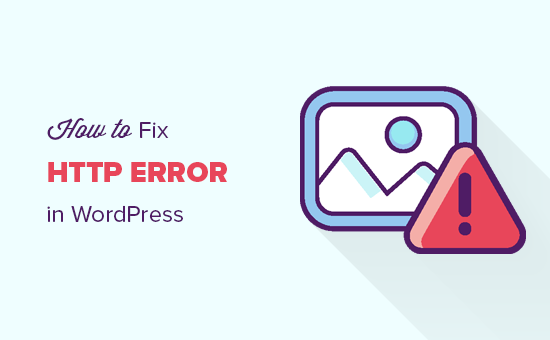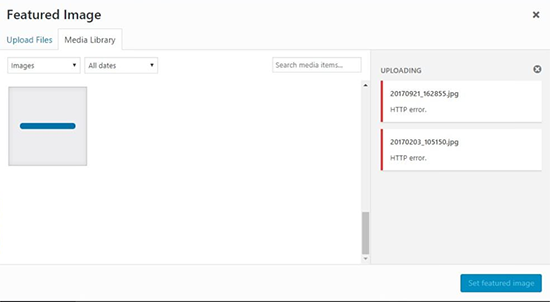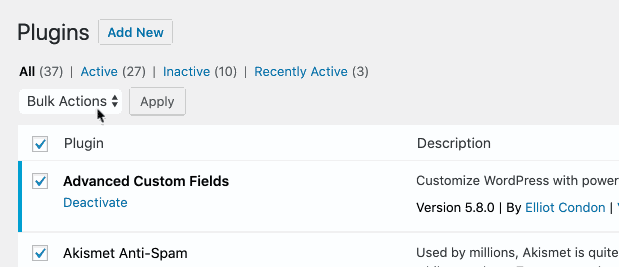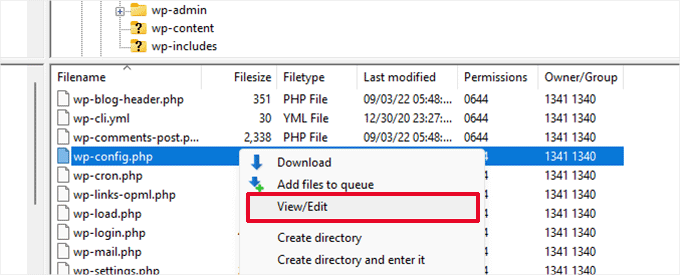Do you need to fix the HTTP image upload error in WordPress?
This error can be particularly frustrating when you are creating content in WordPress. It usually occurs when you are uploading an image or other files to the CMS using the built-in WordPress media library.
In this article, we will show you how to easily fix the HTTP image upload error in WordPress.

What Causes the HTTP Error During Media Upload in WordPress?
Many things could lead to an HTTP error when you are trying to upload files to your WordPress website using the WordPress media uploader.
Basically, WordPress is unable to figure out the cause, and that’s why it displays the generic ‘HTTP error’ message.

The frustrating thing about this WordPress HTTP error is that it doesn’t give you any clue about what may have caused it. This means that you will have to try different solutions to find the cause and fix the error.
That being said, let’s take a look at how to troubleshoot and fix the HTTP error during media upload in WordPress. Feel free to use the links below to skip to a specific method:
- Method 1: Make Sure the HTTP Error Is Not Temporary
- Method 2: Deactivate All Plugins and Your Current Theme
- Method 3: Increase WordPress Memory Limit
- Method 4: Change the Image Editor Library Used by WordPress
- Method 5: Use the .htaccess Method
- Method 6: Update Your PHP Version
- Method 7: Check File and Folder Permissions
- Method 8: Enable Debug Mode
- Method 9: Check Your Hosting Resources
Don’t want to fix image issues yourself? WPBeginner Pro Services can help! With our affordable Emergency WordPress Support Services, you can hire experts to fix image issues, resolve plugin and theme errors, optimize the WordPress database, and much more. Schedule WordPress Support Services today!
Method 1: Make Sure the HTTP Error Is Not Temporary
First, you should wait a few minutes and then try uploading your image file again to your WordPress website. This error is sometimes caused by unusual traffic and low server resources, which are automatically fixed on most WordPress hosting servers.
If that doesn’t work, then you may want to try one or more of the following:
- Refresh your browser or clear your browser cache.
- Resize and rename the file and upload it again to the media library. Check out our list of image optimization plugins to reduce your file size.
- Save the file in a different format. For example, you can change JPEG to PNG using image editing software. After that, retry uploading the file.
If following all these steps still results in the HTTP error, then the error is not caused by a temporary glitch and definitely needs your immediate attention.
Method 2: Deactivate All Plugins and Your Current Theme
If you just installed a new WordPress plugin recently, it may be incompatible with your other plugins and disrupt the image upload process. To see if this is the case, you can deactivate all your WordPress plugins.
If the HTTP error disappears after deactivating a WordPress plugin, then that may be the culprit behind the HTTP upload image error. You can install an alternative plugin or contact the developer for support.
For more information, check out our guide on how to easily deactivate all WordPress plugins and how to deactivate plugins when the WordPress dashboard is inaccessible.

Similarly, sometimes theme conflicts can also disrupt the image upload process. Themes can include functionalities that might interfere with how WordPress handles media uploads.
Luckily, identifying a theme conflict is relatively straightforward. You can temporarily switch to a default WordPress theme. For more information, check out our guide on how to properly change WordPress themes.

Once the default theme is active, try uploading an image again. If the error disappears, then the issue likely lies with your current theme. In this case, you can check if a theme update is available. Often, updates fix compatibility issues and bugs.
Or, you can reach out to the theme developer for support. They might be able to provide a patch or offer guidance on resolving the conflict.
Method 3: Increase WordPress Memory Limit
WordPress is written in the PHP programming language. Additionally, the amount of memory allocated for different PHP processes is determined by your web hosting server.
If uploading images requires more PHP memory than is available, you may see the HTTP image upload error in WordPress.
To fix this, you need to increase the memory PHP can use on your server.
You will first need to access your site’s files using an FTP client or the File Manager app in your web hosting dashboard. Next, go to your root directory and find the wp-config.php file.

You will then need to edit the wp-config.php file using a text editor and add the following line of code to it:
define( 'WP_MEMORY_LIMIT', '256M' );
This code increases the WordPress memory limit to 256MB, which would be enough to fix any memory limit issues.
Finally, you must save and upload the file back to the server.
To learn more, please see our step-by-step guide on how to increase the PHP memory limit in WordPress.
Method 4: Change the Image Editor Library Used by WordPress
WordPress runs on PHP, which uses two modules to handle images. These modules are called GD Library and Imagick. WordPress may use either one of them, depending on which one is available.
However, Imagick often runs into memory issues, causing the HTTP error during image uploads. To fix this, you can make the GD Library your default image editor.
You can do this by simply adding this code to your WordPress theme’s functions.php file or using WPCode (recommended):
function wpb_image_editor_default_to_gd( $editors ) {
$gd_editor = 'WP_Image_Editor_GD';
$editors = array_diff( $editors, array( $gd_editor ) );
array_unshift( $editors, $gd_editor );
return $editors;
}
add_filter( 'wp_image_editors', 'wpb_image_editor_default_to_gd' );
For more details, you can see our guide on how to add custom code in WordPress.
After adding this code, you can retry uploading files using the media uploader. If this doesn’t solve the issue, then you can remove this code and try other methods described in this article.
Method 5: Use the .htaccess Method
This method allows you to control how Imagick uses server resources. Many shared hosting providers limit Imagick’s ability to use multiple threads for faster image processing. However, this will result in you seeing the HTTP error when uploading images.
An easy fix is to add the following code in your .htaccess file:
SetEnv MAGICK_THREAD_LIMIT 1
This code simply limits Imagick to use a single thread to process images.
Method 6: Update Your PHP Version
If your WordPress site is using an outdated version of PHP, then it could trigger the HTTP image upload error. This is because newer PHP versions have performance improvements and generally use less memory.
Luckily, it’s easy to check and update your site’s PHP version. For more details, please see our beginner’s guide on how to update your PHP version in WordPress.
Method 7: Check File and Folder Permissions
WordPress relies on specific file and folder permissions to function properly. Incorrect permissions can prevent WordPress from accessing or modifying files, leading to upload errors.
For instance, if the upload directory lacks proper write permissions, WordPress won’t be able to save uploaded images.
To ensure correct permissions, check out our guide on how to fix the file and folder permissions error in WordPress.
Method 8: Enable Debug Mode
Sometimes, underlying PHP errors can manifest as the HTTP image upload error, making troubleshooting difficult.
Enabling debug mode in your WordPress configuration will reveal any PHP errors in the debug log, providing valuable clues about the root cause of the upload issue.
For instructions on enabling WP_DEBUG mode, refer to our article on how to enable WordPress debug mode. This guide will provide step-by-step instructions on adding the necessary code to your wp-config.php file.
Method 9: Check Your Hosting Resources
If your website reaches its storage quota or encounters limitations on server resources, you might experience upload errors. For instance, insufficient disk space can prevent WordPress from creating new files or folders needed for image uploads.
Most web hosting providers offer a control panel where you can view your website’s resource usage, including disk space. If you’re unable to see it, contact your web hosting provider’s support team for assistance.
If you’re nearing your storage limit, consider optimizing your resources. For example, large image files can consume significant storage. You can optimize your images to reduce their file size before uploading.
If optimizing resources isn’t enough, consider upgrading to a hosting plan with more storage space. This will provide the additional capacity needed for your website’s files.
If you’re looking for a reliable WordPress hosting provider with generous storage space, Bluehost is a popular option. They offer various plans to suit different website needs.

We hope this article helped you fix the HTTP image upload error in WordPress. You may also want to see our ultimate list of the most common WordPress errors and how to fix them, and the most common block editor problems.
If you liked this article, then please subscribe to our YouTube Channel for WordPress video tutorials. You can also find us on Twitter and Facebook.





Syed Balkhi says
Hey WPBeginner readers,
Did you know you can win exciting prizes by commenting on WPBeginner?
Every month, our top blog commenters will win HUGE rewards, including premium WordPress plugin licenses and cash prizes.
You can get more details about the contest from here.
Start sharing your thoughts below to stand a chance to win!
John says
not worked with any method
WPBeginner Support says
If none of the methods in this article worked, you may want to reach out to your hosting provider to try the general troubleshooting steps in our article: https://www.wpbeginner.com/beginners-guide/beginners-guide-to-troubleshooting-wordpress-errors-step-by-step/
Admin
Sandy says
I tried Option 3. Now my entire home page is blank. Individual pages are still there. The Sidebar is still visible, but the rest of the home page is blank.
Please help if possible.
Thank you,
Sandy
WPBeginner Support says
You may want to ensure you didn’t change your homepage settings while troubleshooting and have you removed the code to see if that solved the missing content?
Admin
Sanju says
Worked like charm Option 3.
While My wordpress admin panel is slow.. Working on it. Any guide?
WPBeginner Support says
You may want to try disabling your plugins to see if one of your plugins could be slowing the admin area.
Admin
Lucas Vidal says
Method #3 worked like a charm
WPBeginner Support says
Glad our guide could help
Admin
Mounika says
Thank a lot ! 3rd option worked for me.
WPBeginner Support says
Glad our article could help
Admin
Rahana Razak says
Thank you sir, its working (3rd one worked for me)
WPBeginner Support says
Glad our article could help
Admin
Adriana says
Hello,
I have tried all of them steps, and none has worked, I am not sure what else to do at this point , as i’m on limited time and would need this fixed , if any other ideas please do help. Thank you so much
WPBeginner Support says
You may want to reach out to your hosting provider to see if they see any errors on their end that could be causing the issue.
Admin
Karan says
Thanks. It works by changing the default image file library.
WPBeginner Support says
Glad our article could help solve the issue
Admin
SL101 says
thank you so much, 3rd solution did the trick.
WPBeginner Support says
Glad our article could help
Admin
DrewDownz says
Number 3! Pow! Now lets hope in shows up in other browsers!
WPBeginner Support says
Glad our article could help
Admin
Salbin Sajan says
Hello brother… Thanks for your article ..
#3 Solved the issue ..
Thanks again ..
WPBeginner Support says
Glad our tutorial could help
Admin
Tina says
Hi,
thanks for this guide. Unfortunately, all these ideas did not work for me. Today, in an attempt to remove the “website is on partially safe” SSL certificate message, I used “Search and Replace” plugin to search my databases for “http” and changed those to “https”. That’s the only thing I could relate to this error, but since I am no expert on this, I don’t know how and if I can fix this or how I can undo these changes. Any help?
WPBeginner Support says
For your site having mixed content you would want to take a look at our SSL issues article rather than this one: https://www.wpbeginner.com/wp-tutorials/how-to-fix-common-ssl-issues-in-wordpress-beginners-guide/
Admin
kyle says
Hi i get the http error everytime i upload an image over 4mbs. I have contacted my web designer and host and they have both tried to load images over 15mbs and it is working for them. However, i have tried mulitple computers on different internet connections and i still get the http error. Can u please help?
WPBeginner Support says
If none of the methods in this article resolve the issue you may want to try creating a new user to see if it is due to an issue with your user or the general troubleshooting steps in: https://www.wpbeginner.com/beginners-guide/beginners-guide-to-troubleshooting-wordpress-errors-step-by-step/
Admin
Hien says
I just wanted to comment, #3 definitely helped with 503 error/http error when uploading pictures sometime. Other time, upload pictures fine.
WPBeginner Support says
Thanks for sharing and glad our article could help resolve the issue
Admin
rahul sharma says
Sir in the function.php where should i put the code??? {in the end or In the middle}
WPBeginner Support says
You would normally want to put added code at the end in case you need to edit or remove the code later
Admin
Cindy says
Thank you so much! The third option worked for me!
WPBeginner Support says
Glad our guide could help
Admin
Mike Gaudreau says
In my case, I simply logged out of the dashboard and right back in and the problem was cleared.
WPBeginner Support says
Thanks for sharing that, it sounds like either your caching had a hiccup or you ran into one of the server issues
Admin
Mohamed says
You can’t imagine the level stress of this HTTP thing has created on me. Number 3 is my lifesaver. Thank you for posting this.
WPBeginner Support says
Glad our article could help
Admin
OA says
Thanks! Option 3 work for me.
WPBeginner Support says
Glad our recommendation worked
Admin
Mohamed says
Thanks…Method 3 did it well
WPBeginner Support says
Glad our article could help
Admin
Janet says
I had about 10 pictures to upload and repeatedly got the HTTP error for 3 of them. I finally sussed that those three had an apostrophe in the file name!!! Doh! Removing the apostrophe was the solution.
WPBeginner Support says
Thanks for sharing your solution, glad you were able to get the files uploaded
Admin
Hector says
Thanks, Number 3 did the trick. Awesome tutorial.
Rae says
No. 3 worked for me too. Thank you for this!
WPBeginner Support says
Glad our article could help
Admin
Sandra says
Thanks for this! Number 3 fixed my problem
William Davidson says
#2 worked for me. Easy peasy. Thanks for helping me fix it.
WPBeginner Support says
Hey William,
Glad you found it helpful. Don’t forget to join us on Twitter for more WordPress tips and tutorials.
Admin
Magloire says
This issue really stressed me up. No 3 solved my problem.
Thanks
Yann says
3 worked for me too. I copied right at the end of function.php in Appearance > editor of WordPress
Eylene says
Hi there,
Option 3 is working for me! Thank you so much this was driving me insane!!!
Alissa says
Before I tried any of these solutions. I tried logging out of WordPress and logging back in, and suddenly I stopped getting the error message. So, you might want to try that first.
Isla S says
I’ve noticed that this keeps happening to me with files that contain apostrophes in the filename. When I remove it, they upload fine
Perhaps try to remove the ‘ ?
Wanda says
THANK YOU! Removing the ‘ worked for me
Andy says
Thank you! This was driving me crazy, had been trying to solve this for a friend for days
Marek says
No. 3 works, thanks.
Christina says
None of these worked for me. After some more researching, I found that putting this bit of code at the bottom of the .htaccess worked for me:
# Exclude the file upload and WP CRON scripts from authentication
Satisfy Any
Order allow,deny
Allow from all
Deny from none
Don’t forget to back up your .htaccess file first just in case!
Savi Huang says
None worked. Pls help!
NICOLE says
Number 4 worked for me!!! Thanks so much!
Pat Smithers says
No. 3 worked a charm.
Thank you so much!
mike says
Please can will this solutions work on a localhost installation of wordpress?
WPBeginner Support says
These methods should work with localhost, the memory limit may need to be modified using the program for your server such as MAMP or WAMP
Admin
Omar Ajruli says
Option number three fixed my problem guys, thank you. Have a great day.
3. Change Image Editor Library Used by WordPress.
Ali HyDer says
Its Working for me! Yuppiiiiiiiiiiiiiiiiii
Thanks Syed Balkhi
Emmanuel Usen Jackson says
My blog shows me “An error occurred in the upload. Please try again later.”. Please what should I do?
Jake says
Try again later
John says
Tried all to no avail UNTIL i added the code to the functions.php file. A BIG thank you!
Dan says
Adding that line to my .htaccess file did the trick! Thanks!
vishwas says
i did all the above changes in my site still image is not uploading, please help me to resolve this issue (http error)
Casey says
THANK YOU! Changing the image editor worked for me.
David says
For me, the issue was a series of pictures with an apostrophe in the title. Renamed and it worked fine.
Tom Jaggard says
I need help resolving the HTTP error when uploading large files. Someone else created my site with an upload size limit of 64Mb. I am trying to upload audio files that are sometimes larger than 64Mb. I added a plug-in (Upload Max File Size) to change my max upload size to 128Mb. I changed memory_limit in PHP.ini to 256M. I change max_execution_time in PHP.ini to 300. I set memory_limit in wp-config to 256M. I changed memory_limit in .htaccess to 256M. I tried adding the code to .htaccess to force it to use the GD Library instead of Imagick. It didn’t work, so I remove that code and then added the line to limit Imagick to 1 thread. In spite of all of these changes, I still get the HTTP error when loading a file larger than 64Mb.
Any more ideas?
Thanks!
siddharth pathak says
thanks a lot, I was trying to fix this from last 2 hour and after reading this article did it in just few sec and already tested thanks a lot
Mauricio Lazo says
As a side note, another thing that can be giving you HTTP errors while uploading images is a configuration in you php.ini file, specifically the line “max_execution_time=30;”.
Some shared hosting providers limit PHP execution to a single core of the server, increasing the time it takes for PHP Imagick to get the image, process it and create thumbnails. So the suggestion is to increase max_execution_time to 120 seconds instead of the default 30 seconds.
wassim jied says
Hello
In my case
function wpb_image_editor_default_to_gd( $editors ) {
$gd_editor = ‘WP_Image_Editor_GD’;
$editors = array_diff( $editors, array( $gd_editor ) );
array_unshift( $editors, $gd_editor );
return $editors;
}
add_filter( ‘wp_image_editors’, ‘wpb_image_editor_default_to_gd’ );
worked fine thanks
Php Memory limit 128Mo v 7.13 apache 2.4
Joost Walter says
One of the causes of an upload error is the fact that there is an apostrophe in the name of the file that you try to upload. For instance a picture called ‘Let’s_dance.jpg’ will give an error, while ‘Lets_dance.jpg’ can be uploaded without any problems.
Floz says
This was the problem in my case, thank you so much!! Saved me a lot of hassle ^_^